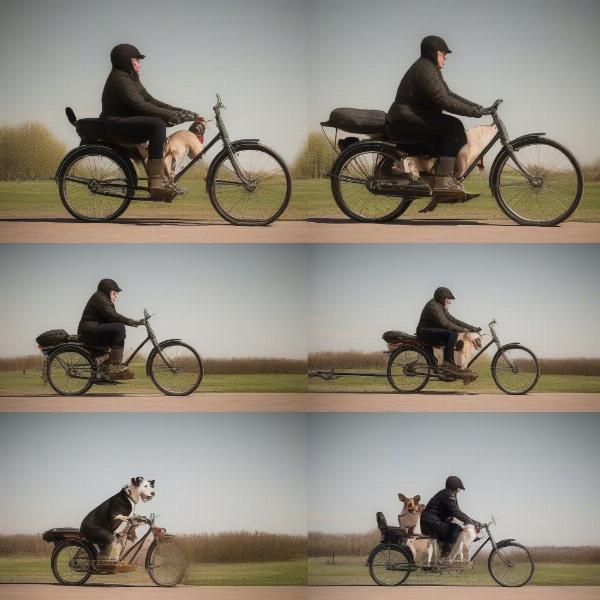A bicycle sidecar for your dog can be a fantastic way to enjoy the outdoors together, offering a safe and comfortable ride for your furry friend. Whether you’re a seasoned cyclist or just starting out, choosing the right sidecar and ensuring your dog’s safety and comfort are crucial for a positive experience. This comprehensive guide will cover everything you need to know about bicycle sidecars for dogs, from choosing the right model to training your dog to ride in it.
Choosing the Perfect Bicycle Sidecar for Your Dog
Selecting the right sidecar depends on several factors, including your dog’s size, weight, and temperament, as well as your cycling habits and budget. Consider these key aspects:
- Size and Weight Capacity: Ensure the sidecar is appropriately sized for your dog, allowing them to sit, lie down, and turn around comfortably. Check the manufacturer’s weight limit to guarantee a safe ride.
- Material and Construction: Look for durable, weather-resistant materials like aluminum or steel for the frame and a robust, washable fabric for the carrier.
- Safety Features: Prioritize sidecars with safety harnesses, reflective strips, and sturdy connections to the bicycle.
- Entry and Exit: Easy access is essential for your dog’s comfort and your convenience. Consider sidecars with ramps, doors, or large openings.
- Suspension and Wheels: A good suspension system will provide a smoother ride for your dog, especially on uneven terrain. Pneumatic tires offer better shock absorption than solid ones.
- Storage: Some sidecars include storage compartments for carrying essentials like water, treats, and waste bags.
Getting Your Dog Used to the Sidecar
Introducing your dog to the sidecar gradually is key to a successful and enjoyable experience.
- Start Slow: Let your dog sniff and explore the sidecar without attaching it to the bicycle. Place treats and toys inside to create positive associations.
- Short Rides: Begin with short, slow rides in a quiet area, gradually increasing the distance and speed as your dog becomes more comfortable.
- Positive Reinforcement: Reward your dog with praise and treats throughout the process, creating a positive and rewarding experience.
- Safety First: Always use a safety harness to secure your dog inside the sidecar.
- Breaks: Take frequent breaks to allow your dog to stretch their legs and relieve themselves.
 Training a Dog to Ride in a Bicycle Sidecar
Training a Dog to Ride in a Bicycle Sidecar
Safety Tips for Cycling with Your Dog
Safety is paramount when cycling with your dog. Follow these guidelines for a safe and enjoyable ride:
- Check the Sidecar Regularly: Inspect the sidecar before each ride for any damage or loose parts.
- Use a Safety Harness: Always secure your dog with a harness specifically designed for bicycle sidecars.
- Visible Gear: Equip your bicycle and sidecar with lights and reflectors, especially when riding in low-light conditions.
- Avoid Extreme Weather: Refrain from cycling in extreme heat, cold, or rain to protect your dog’s health and comfort.
- Stay Alert: Pay close attention to your surroundings and be prepared for unexpected obstacles or traffic situations.
Conclusion
A bicycle sidecar for dog can be a wonderful way to share your love of cycling with your furry companion. By choosing the right sidecar, training your dog patiently, and prioritizing safety, you can create memorable and enjoyable adventures together. Remember to always prioritize your dog’s comfort and well-being to ensure a positive experience for both of you.
FAQ
-
How do I choose the right size bicycle sidecar for my dog? Measure your dog’s length and height and compare it to the sidecar’s dimensions. Ensure there’s enough space for your dog to sit, lie down, and turn around comfortably.
-
Can I use a regular dog harness in a bicycle sidecar? No, it’s crucial to use a harness specifically designed for bicycle sidecars to ensure your dog’s safety and prevent them from jumping out.
-
What type of bicycle is best for a dog sidecar? A sturdy bicycle with good brakes and handling is recommended. Avoid lightweight or racing bikes.
-
How can I make my dog more comfortable in the sidecar? Add a comfortable pad or blanket and ensure the sidecar is well-ventilated. Start with short rides and gradually increase the duration.
-
Is it safe to cycle with a dog in a sidecar on busy roads? It’s best to avoid busy roads and stick to quieter routes, such as bike paths or trails.
-
What should I do if my dog is anxious in the sidecar? Stop the bike and reassure your dog. Try offering treats and praise. If your dog continues to be anxious, consider seeking professional advice from a dog trainer.
-
How do I clean my dog’s bicycle sidecar? Most sidecars have removable and washable fabric liners. Follow the manufacturer’s instructions for cleaning.
ILM Dog is your trusted source for expert advice on all aspects of dog care and companionship. We provide comprehensive information on dog breeds, health, training, nutrition, grooming, and much more. Whether you’re a new dog owner or a seasoned enthusiast, ILM Dog is here to support you every step of the way. For personalized guidance, contact us at [email protected] or call us at +44 20-3965-8624.